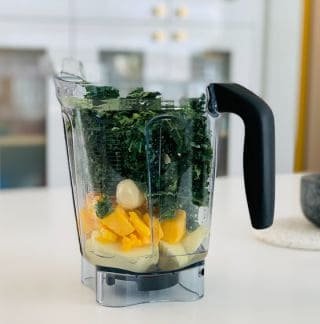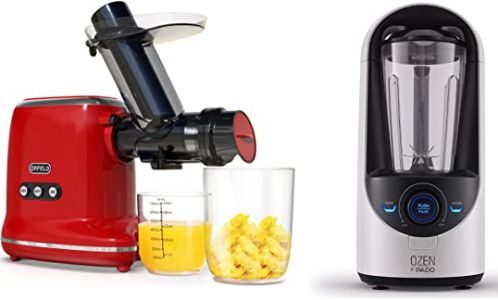If you like your juices and smoothies to be rich, full of nutrients, and tasty, this article will help you get them exactly how you like by comparing a slow juicer vs vacuum blender. You can make your drinks in a blender or juicer. But before we do that, it is important to know that blending and juicing are two different processes and within those processes are a few different types of blenders and different types of juicers that do the job.
Blending will pulverize the fruits or vegetables completely. A juicer will crush and separate the pulp from the juice. Exposure to oxygen will lead to a loss of nutrients and cause the juice or smoothie to separate faster, which is not very healthy. Oxidation will also result in loss of taste, texture, and color of the juice. Heat destroys essential vitamins, which are vital to boosting immunity and protecting cells. To preserve those nutrients, you need to make sure that they’re kept as far away from heat and oxygen as possible.
This is why you should make sure that you make your juice in an appliance that will not degrade its nutrients completely. Additionally, preventing your juice or smoothie from separating or developing excess foam will make the juice tastier, give it a better texture and retain its original color. To keep your juice rich with nutrients, you can buy either a slow juicer or a vacuum blender, as centrifugal juicers and regular blenders can’t do the job well.
Table of Contents
Difference between a Slow Juicer and a Vacuum Blender
Slow juicers consist of a jug, a sharp-toothed rotating surface or screen, and a juice collecting cup. These separate the pulp and the juice by crushing the ingredients slowly and some juicers allow you to remove all pulp by using a screen while others let you retain some pulp in the glass. They are versatile to use. They retain maximum nutrients, as there is no heat produced that would destroy the juice or smoothie’s enzymes and antioxidants. Oxidation during juicing is also minimal but once the juice is made, the oxidation process starts because it has been exposed to air. There are two types of slow juicers, horizontal and vertical, the differences between which we have already explained in detail. People who are health enthusiasts might find that slow juicers will meet their hydration needs.
On the other hand, a vacuum blender will create a vacuum within the jar to prevent contact of air with the ingredients. This oxidization of the nutrients may arise in a regular blender. The vacuum also improves the blending of the ingredients, leads to smoother textures, and prevents any separation of the juice because bubbles and foam are prevented from forming. This will also nicely retain the juice’s taste and nutrition and keep it fresh for a longer time. Compared to a slow juicer, a blender with vacuum will produce a thicker drink because the fiber has not been removed.
Vacuum blenders are of two types. Simple models come with a separate vacuum pump that operates on batteries and that you attach to the top of the jug to suck out all the air. Some models have an electric inbuilt vacuum pump that sucks out the air from the jar. If you want to check some out, we can recommend the best vacuum blenders of each type.
Additionally, there’s a vacuum seal in the jar’s lid that maintains the vacuum condition in the jug, which is why the jug itself can hold the blended juice or smoothie until the sealed lid is removed. This will increase the shelf life of the drink in the fridge for a long time without allowing it to oxidize. This can be a beneficial feature for people who don’t have time to make a healthy drink every morning.
Advantages of a Vacuum Blender
Retains taste and color
 In addition to the loss of health benefits, the presence of oxygen degrades the juice’s flavor and color. Vacuum blenders retain taste and the vibrant colors of the final product, as they blend the ingredients in a complete vacuum, with the lack of oxygen. This doesn’t give the microbes a chance to spoil the juice or change its color or taste, and it will stay fresh for up to a week in the blender’s sealed jug.
In addition to the loss of health benefits, the presence of oxygen degrades the juice’s flavor and color. Vacuum blenders retain taste and the vibrant colors of the final product, as they blend the ingredients in a complete vacuum, with the lack of oxygen. This doesn’t give the microbes a chance to spoil the juice or change its color or taste, and it will stay fresh for up to a week in the blender’s sealed jug.
Smooth texture
Smoothies or juices blended in a vacuum blender will always have a smooth texture, and there will be no formation of air bubbles or foam. This also prevents the drink from separating.
Minimal wastage
Vacuum blenders cut down on a lot of waste as the ingredients get blended cohesively in the jug. This does not leave any pulp or juice as waste. Therefore all the nutrients are preserved in the jug, and none of it gets wasted.
More versatile
In addition to making juices and smoothies, a vacuum blender can make a batch of soup really fast and you don’t need to use the vacuum function for it. Also, try making pesto and you’ll find that the vacuum keeps it from discoloring because of the lack of oxygen.
Disadvantages of a Vacuum Blender
Expensive
Although a few consumer models are not very expensive, superior vacuum blenders are pricier than traditional blenders because of the addition of a vacuum feature. If you’re a regular juice or smoothie drinker and very health conscious, then you might be able to justify the price.
Time-consuming
It takes a little longer to blend things in a vacuum blender than a regular blender since the vacuum pump needs to run first. This might not be ideal if you need to blend your beverage quickly or blend ingredients for your other recipes in a time constraint.
Heavy Body
Vacuum Blenders are heavy and bulky to store because of their extra hardware for the vacuum function and larger jars. It is not practical to move them from one place to another regularly.
Noisy
Vacuum blenders generally create a lot more noise than traditional blenders. Traditional blenders are loud as it is, and vacuum blenders with the simultaneous working of the vacuum pumps become a lot noisier. The prolonged noise can get quite disturbing.
Advantages of a Slow Juicer
Fresh pulp
 A slow juicer crushes the ingredients to extract the juice. The crushed dry pulp is expelled into a separate container from your glass of juice. Since it contains many essential nutrients and fiber, it can be used in other recipes. It can also be added to a broth or a soup or into cakes and cookies, depending on the ingredients of the pulp.
A slow juicer crushes the ingredients to extract the juice. The crushed dry pulp is expelled into a separate container from your glass of juice. Since it contains many essential nutrients and fiber, it can be used in other recipes. It can also be added to a broth or a soup or into cakes and cookies, depending on the ingredients of the pulp.
Rich with nutrients
The fresh juice extracted out of a slow juicer is rich in nutrients and very healthy to drink. When the slow juicer processes the fruits/vegetables, it preserves most of the nutrients. These nutrients would otherwise normally be destroyed to a good extent in a traditional blender or centrifugal juicer.
Easy to process leafy greens
Leafy greens such as kale, spinach, mint, wheatgrass are ordinarily hard to process in a centrifugal juicer as they are quite rough in texture. However, slow juicers slowly cut and crush them to extract maximum nutrients from them.
Long-lasting freshness
The juice pressed by slow juicers stays fresh for at least 3-4 days if stored properly. If you’re running short on time every morning to make yourself some juice, you can make extra on weekends and store it well so that you can drink it whenever you want.
Less noise
Slow juicers are significantly quieter than fast juicers. This keeps noise levels in the kitchen to a minimum.
Disadvantages of a Slow Juicer
Time-consuming
A slow juicer takes plenty of time to make juice as it runs slowly and ingredients have to be fed into it in smaller pieces. Also, cleaning the juicing screen and the processing chamber will also add to your juicing time. Depending on the amount of ingredients used, slow juicers can take up to three times longer than a centrifugal juicer. So if you have a rushed routine, you may not have the time to use a slow juicer.
Expensive and heavy
They are usually more expensive than a centrifugal juicer. They are also larger and heavier due to their heavy motor. The price could be a barrier for this product, although some advanced centrifugal juicers can be just as expensive.
Complete straining is not guaranteed
Most of the pulp is ejected into another container, but the strainer will not completely separate the pulp. Some might get stuck on the cutting screen, so you’ll have to clean the pulp from there and the jar, which will make using it just more time-consuming.
Wastage
A lot of pulp might go to waste if it is not being used for anything else. This also leads to the wastage of nutrients in that pulp. If you want to minimize wastage of vital nutrients, you’ll have to add that pulp into other recipes, like stews or cookies.
Conclusion: Is Vacuum Blending Better?
If you want to retain the fiber from fruits and vegetables, vacuum blending is better than slow juicing as there’s no wastage and it blends everything together, including the fiber. It also produces a thicker drink. The blending experience is better, as there’s no oxidization at all until the blending jar is opened and no air bubbles. In a slow juicer, the pulp is removed and air bubbles can form.
Vacuum blending also gives the smoothies a better taste and preserves more nutrients than slow juicing. Vacuum blenders also keep the juices fresh for a longer time. Additionally, it is also a faster process and requires a little less maintenance than a slow juicer.
If you don’t like fiber at all in your drink, then a slow juicer is a better choice for you.
Each appliance has its own merits, depending on what you need them for. Therefore, you must choose one after carefully analyzing your own needs.
We hope this article cleared any confusion surrounding vacuum blenders and slow juicers and gave you enough information to choose which one you might need.


